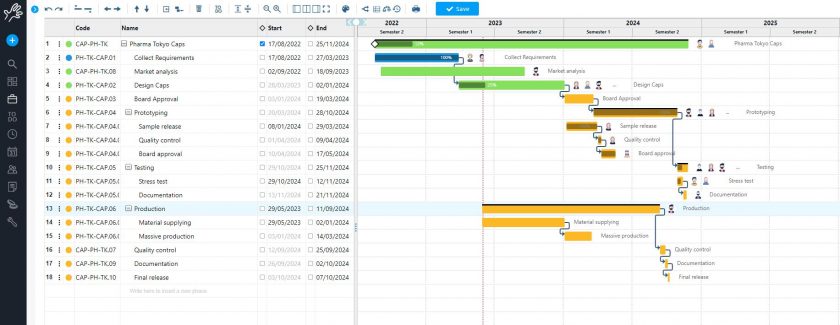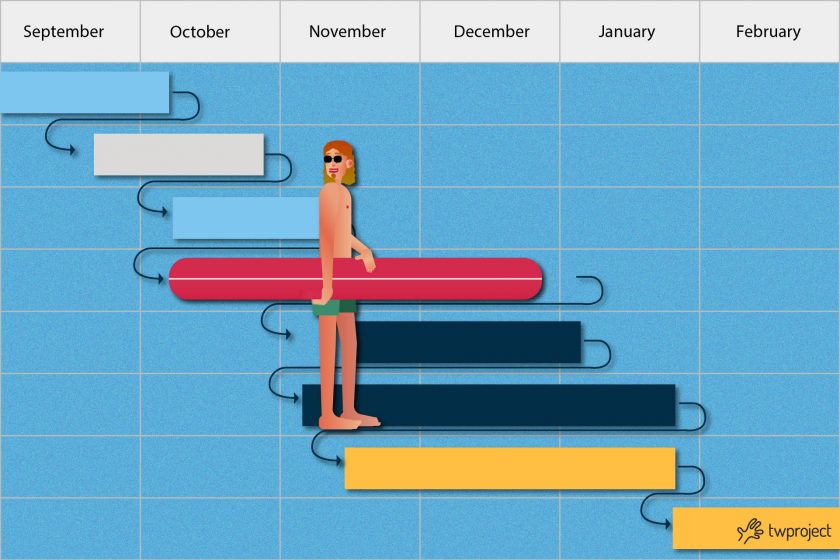Preparing a project with Gantt is critical in ensuring efficient planning and optimal management of activities.
Using this visual tool, you can organize, assign and monitor activities, enabling precise control and better resource allocation.
CONTENT
- 6 steps to prepare a project
- 1.Analysis
- 2.Project type identification
- 3.Project objectives definition
- 4.Project planning
- 5.Project monitoring and control
- 6.Project closure
- How to prepare a project: the Gantt chart with Twproject
- Analyze dependencies between activities with the Gantt Chart
- Works on the elasticity of dependencies and flexibility in project planning
- Implements some time flexibility in the project Gantt
- Create selective access a project’s Gantt
- Create custom views and play with colors
- Identifies Risks and prepares contingency plans
- Documents and archives project and Gantt evolutions
In this article, we will explore how to prepare a project using Gantt and how to make the most of its potential.
6 steps to prepare a project
1. Analysis
The first step in preparing a project is to understand the context in which it fits.
During this preliminary stage, conducting a thorough analysis of the context in which the project fits is essential.
This involves carefully analyzing the environment, including customer requirements, available resources, time conditions, and technical constraints. Furthermore, it is critical to identify and anticipate potential risks.
The main objective of context analysis is to understand project stakeholders’ needs and expectations clearly.
This involves active dialogue with the client, project team, and other relevant stakeholders.
During discussions and interviews, it is crucial to ask targeted questions to gather critical information about project needs, wants, and restrictions.
In addition to understanding project needs, context analysis helps identify and assess potential risks.
This makes it possible to anticipate the challenges and potential complications that might occur during project execution. For example, financial constraints, technological limitations, or human resource issues could exist.
Early identification of such risks enables the project manager to plan mitigation actions and avoid unforeseen contingencies adequately.
During the context analysis, it is also important to gather detailed information on the availability of resources needed for the project.
This includes assessing the skills and capabilities of the project team and identifying the material and financial resources needed to achieve the established goals.
This information will be helpful in the next phase of activity definition and time planning.
2. Project type identification
For any project, clarity is the key to success.
There are different types of projects, each with its peculiarities and needs.
For project implementation, it is crucial to identify the type of project you are working on correctly.
For example, it could be a software development project, construction building, or marketing project.
Understanding the type of project helps define the activities and resources needed for its success.
The first thing to do is, therefore, to present the project clearly.
This implies accurately describing the project objectives, activities, and resources needed.
A good presentation of the project helps gain stakeholders’ support and approval and creates a solid foundation for its implementation.
3.Project objectives definition
Once the context is understood and the type of project identified, the next step is to define the objectives. These must be clear, measurable, achievable, relevant, and time-bound, following the SMART (Specific, Measurable, Achievable, Relevant, Time-bound) criterion.
The project manager must work closely with stakeholders to ensure that goals are aligned with everyone’s expectations and needs. Once goals are set, they become the compass that directs all future decisions and actions.
4.Project planning
Project planning is a crucial phase that includes defining specific tasks, allocating resources and determining delivery schedules.
A good project management tool, such as Twproject, can facilitate this step by providing features that help create and manage the project plan.
During planning, the project manager must consider various factors, including budget, deadlines, team skills, potential risks, and client expectations.
Planning must be flexible and adaptable, as circumstances may change during the project life cycle.
5.Project monitoring and control
Monitoring the progress of the project and controlling its variables are essential to ensure that everything is proceeding according to plan.
Project management software such as Twproject, with its reporting and tracking capabilities, can significantly simplify this step.
The project manager can use these tools to monitor project progress, identify problems before they become critical, and make necessary changes in time.
6.Project closure
Finally, a good design must have a well-defined closure. This includes analyzing the results achieved, comparing them with the initial goals, and identifying strengths and areas for improvement. At this stage, it is also essential to recognize the contributions of all team members and celebrate the success achieved.
How to prepare a project: the Gantt chart with Twproject

After defining the project goals and the activities involved, you can proceed to create the Gantt chart.
The diagram displays project activities along a time axis, giving the project manager a clear view of dependencies between activities, expected durations, and deadlines.
This can be created using specially designed project management software, such as Twproject, which simplifies the creation and management of these diagrams.
Creating the Gantt chart with Twproject is indeed simple and intuitive.
The latter provides a clear and detailed view of the activities, with respective horizontal bars representing the expected duration of each activity. In addition, you can customize the Gantt to suit your needs, including additional information such as resources assigned to each activity, milestones, or time constraints.
If changes occur in the planning or progress of activities, the necessary changes can be made directly in the diagram.
Dependencies between activities are automatically managed by Twproject, which adjusts the Gantt chart accordingly. This makes change and update management more efficient and faster.
In addition, the software allows sharing of work with the project team or stakeholders.
It is possible to export the diagram in different formats to facilitate communication and information sharing.
This way, all team members can have a clear and shared view of the project’s activities and execution time.
Analyze dependencies between activities with the Gantt Chart
Don’t limit yourself to sequential dependencies; also explore start-to-start, end-to-end, and other dependencies to represent complex relationships among activities
There are different types of relationships between activities in a project.
- The so-called classical Finish to Start (FS) stipulates that activity A must finish before activity B starts, or in other words, activity B cannot begin before A is finished.
- The Finish to Finish (FF) relationship implies that activity B cannot finish before activity A is also finished. This relationship is typical in scenarios where activity B depends on the completion of activity A, such as in the case of writing a book, where activity B represents the completion of the entire book and activity A is the writing of the last chapter.
- Start to start (SS), in which an activity cannot begin before another activity begins. For example, the project management activity of a project cannot start before the project begins.
- Finally, there is the type of relationship called Start to Finish (SF), in which activity A must start before B finishes. This relationship can be complex to understand and applies only in specific contexts. For example, in a manufacturing plant with shifts, the next shift (B) cannot finish until the initial shift (A) has started to ensure continuous machinery monitoring.
In Twproject, after creating the dependency between two phases, it is possible to change the default value represented by the FS dependency and select another relationship type. This expands the possibilities of dependency management and allows project managers to better adapt to the specific needs of their project.
We create and manage complex projects using Twproject’s interactive and user-friendly Gantt chart

Works on the elasticity of dependencies and flexibility in project planning
The elasticity of dependencies is a crucial factor to consider when developing a project with Gantt.
In many software, assigning a dependency involves a linear succession of activities without overlapping or empty time.
However, in the real world, the phases of a project do not always follow one another rigidly.
Twproject has introduced the ability to freely manage this elasticity.
When you insert a dependency, it is initially saved with the default FS hard type. However, converting this “hard” dependency to an “elastic” dependency with any relationship type is possible.
This means that two interdependent activities may not be chronologically consecutive, leaving gaps between them or overlapping for some time, as long as the logic of chosen dependence is respected.
This elasticity provides more flexibility in acting on the end dates of project phases without necessarily resulting in slippage of subsequent phases.
For example, consider a project tree in which a project manager (PM) is assigned for the entire project and a specific PM for each phase, such as analysis (PMA), design (PMG), and production (PMD).
Using elastic dependencies, the PM can define a total project duration and assign phases to a specific period. This allows PMs of individual phases more freedom of action in managing their phases’ start and end dates without interfering with the overall project dates.
Implements some time flexibility in the project Gantt
- Time Buffers: insert time buffers between key phases to absorb any delays without affecting overall deadlines.
- Periodic Review: schedule regular reviews of the Gantt to ensure that it always reflects the reality of the project.
Create selective access a project’s Gantt
Working with Gantt is great, but sometimes team members can get lost in the charts. To help the entire team focus on what is relevant, use Twproject’s features to grant selective access to the Gantt so that each team member can see only what is relevant to their role.
Create custom views and play with colors
– Customized Views: create customized views of the Gantt for different stakeholders, highlighting the most relevant information for each.
– Use of symbols and colors: use symbols and colors to make the Gantt more readable and to highlight key information.
Identifies Risks and prepares contingency plans
– Risk identification: uses the Gantt to identify potential risks, such as overlapping or conflicting resources.
– Contingency plans: prepare contingency plans for critical events and represent them in the Gantt so that you can act quickly if necessary.
Documents and archives project and Gantt evolutions
– Decision reporting: document key decisions and changes in the Gantt so that you have a historical record.
– Version archiving: save and archive key versions of the Gantt for future reference or post-project analysis.
Do you see how many things you can do with a Gantt in preparing a project?
Indeed, preparing a project with the Gantt is a process that requires key setting of elements, good planning, a clear definition of objectives, and proper identification of activities and dependencies.
Using tools like Twproject and the Gantt chart, project managers can effectively manage projects, achieve successful results, and keep on schedule.




